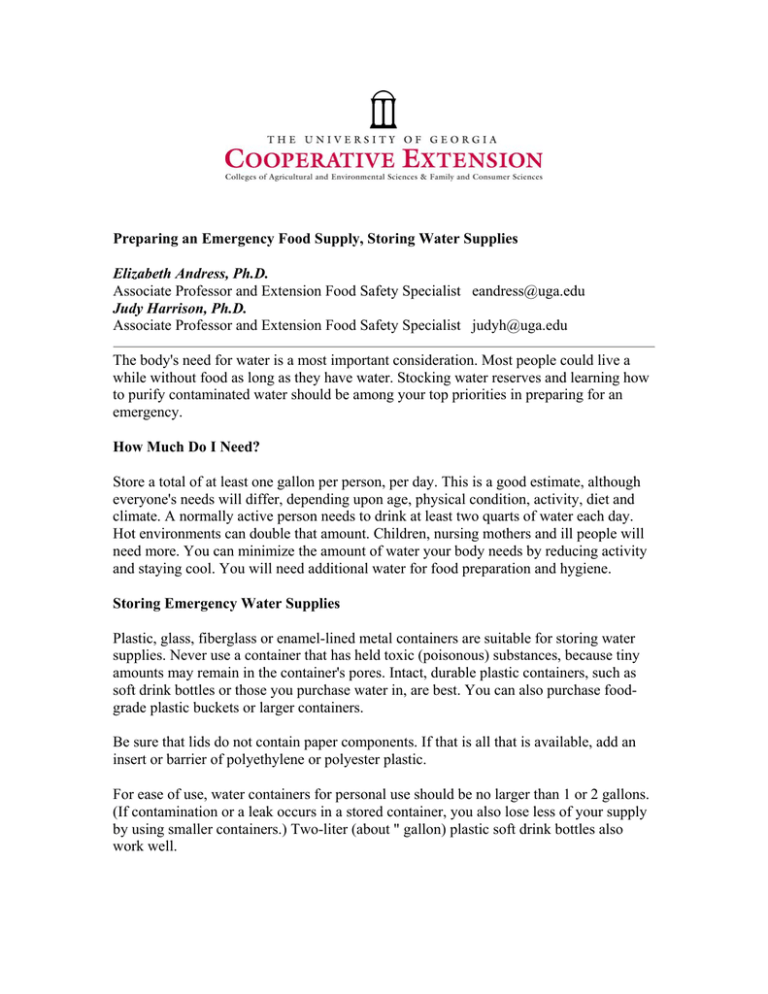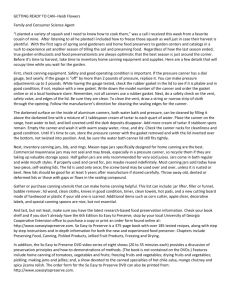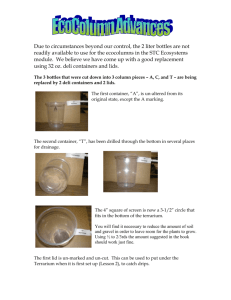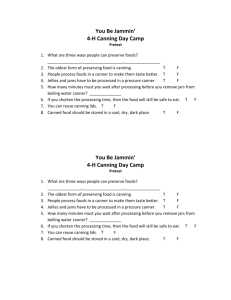Preparing an Emergency Food Supply, Storing Water Supplies Elizabeth Andress, Ph.D.
advertisement

Preparing an Emergency Food Supply, Storing Water Supplies
Elizabeth Andress, Ph.D.
Associate Professor and Extension Food Safety Specialist eandress@uga.edu
Judy Harrison, Ph.D.
Associate Professor and Extension Food Safety Specialist judyh@uga.edu
The body's need for water is a most important consideration. Most people could live a
while without food as long as they have water. Stocking water reserves and learning how
to purify contaminated water should be among your top priorities in preparing for an
emergency.
How Much Do I Need?
Store a total of at least one gallon per person, per day. This is a good estimate, although
everyone's needs will differ, depending upon age, physical condition, activity, diet and
climate. A normally active person needs to drink at least two quarts of water each day.
Hot environments can double that amount. Children, nursing mothers and ill people will
need more. You can minimize the amount of water your body needs by reducing activity
and staying cool. You will need additional water for food preparation and hygiene.
Storing Emergency Water Supplies
Plastic, glass, fiberglass or enamel-lined metal containers are suitable for storing water
supplies. Never use a container that has held toxic (poisonous) substances, because tiny
amounts may remain in the container's pores. Intact, durable plastic containers, such as
soft drink bottles or those you purchase water in, are best. You can also purchase foodgrade plastic buckets or larger containers.
Be sure that lids do not contain paper components. If that is all that is available, add an
insert or barrier of polyethylene or polyester plastic.
For ease of use, water containers for personal use should be no larger than 1 or 2 gallons.
(If contamination or a leak occurs in a stored container, you also lose less of your supply
by using smaller containers.) Two-liter (about " gallon) plastic soft drink bottles also
work well.
Five- or ten-gallon storage drums (intended for water or food) will work well for larger
supplies.
Thoroughly wash the container and lid immediately before filling it with treated water
(see below). Use clean, hot water and detergent. Rinse well with hot water after washing.
Before storing your water, treat it with a preservative, such as chlorine bleach, to prevent
the growth of microorganisms. Use liquid household chlorine bleach that contains 5.25
percent sodium hypochlorite and no soap. Do not use scented or "color safe" bleaches or
bleaches with added cleaners. Some bleach containers warn, "Not For Personal Use."
You can disregard these warnings if the label states sodium hypochlorite is the only
active ingredient and if you use only the small quantities in these instructions.
Add four drops of bleach per quart of water and stir. Seal your water containers tightly,
label them ('Purified Drinking Water'), date them and store them in a cool, dark place.
Some Quick Conversion Figures
Amount of Water
1 quart
Amount of Bleach
4 drops
1/2 gallon (about 2 liters) 8 drops or 1/8 teaspoon
1 gallon
16 drops or 1/4 teaspoon
Finding Water in Emergencies
If you haven't put water away in preparation for emergency use during disasters, you do
have some other options.
Hidden Water Sources in Your Home
If a natural disaster catches you without a stored supply of clean water, consider all water
from wells, cisterns and other delivery systems in the disaster area unsafe until tested.
You can prevent contaminated water from entering your house by closing the main
incoming water valve. This is especially important if you hear reports of broken water or
sewage lines in the area.
The tank of your hot water heater or water pressure tank can supply many gallons of
emergency water. You could also use water in your plumbing and in ice cubes. As a last
resort, you can use water in the reservoir tank of your toilet (not the bowl), but purify it
first (described later).
To use the water in your hot water tank, first turn off the electric or gas supply to the
water heater. (Turn off the gas at the intake valve or turn off the electricity at the circuit
breaker, or unplug the unit.) Open the drain at the bottom of the tank to retrieve the water.
Start the water flowing by turning off the water intake valve and turning on a hot-water
faucet. Do not turn on the gas or electricity when the tank is empty. When power is
restored and the tank refills with water, turn on the gas or electric to heat the water.
To use the water in your pipes, open (turn on) the faucet at the highest point in your
house. This lets air into the plumbing system. Now you can drain the water from the
pipes through the lowest faucet in the house. If the main water valve is closed, be sure
that gas to heat the water is turned off to prevent overheating.
Water beds hold up to 400 gallons, but some water beds contain toxic chemicals that are
not fully removed by many purifiers. If you designate a water bed in your home as an
emergency resource, drain it yearly and refill it with fresh water containing two ounces of
bleach per 120 gallons.
Emergency Outdoor Water Sources
If you need to seek water outside your home, you can use the sources listed below if you
purify the water before using or drinking it.
•
•
•
•
Rainwater
Streams, rivers and other moving bodies of water
Ponds and lakes
Natural springs
Avoid water with floating material, an odor or dark color. Use saltwater only if you distill
it first (described later).
Using Water in Emergencies
In addition to having a bad odor and taste, contaminated water can contain
microorganisms that cause diseases such as dysentery, cholera, typhoid and hepatitis.
Purify all water of uncertain condition before using it for drinking, food preparation
(including cleaning and cooking) or personal hygiene (brushing your teeth, etc.).
There are many ways to purify water. None are perfect. Often the best solution is a
combination of methods. If the water looks cloudy, filter it before purifying. First, let the
water sit undisturbed so that any suspended particles settle to the bottom. Then filter the
water through layers of clean paper or cotton towels, cheese cloth, or coffee filters. A
clean cotton plug in a funnel will also work, as will filters designed for camping and
backpacking.
There are two common, easy purification methods for water that can be used prior to
consuming or using water. These measures will kill microbes but will not remove other
contaminants such as heavy metals, salts, most other chemicals and radioactive fallout.
Boiling
Boiling is the safest method of purifying water. Place the water in a clean saucepan or
other cooking container. Bring the water to a rolling boil and continue boiling for 10
minutes, keeping in mind that some water will evaporate. Let the water cool before
drinking, keeping it covered during cooling.
Boiled water may taste "flat" when opened. Improve the flavor by incorporating air into
the water by shaking, or pouring it back and forth between two clean containers.
Chlorination
Chlorination uses liquid household chlorine bleach to kill microorganisms. (See page 1
for information on the types of chlorine bleach that are safe to use.) Add two drops of
bleach per quart of water (four drops if the water is cloudy), mix thoroughly and let stand
for 30 minutes. If the water does not slightly taste and smell of chlorine at that point, add
another dose and let stand another 15 minutes. Test again.
If you do not have a dropper, use a spoon and a square-ended strip of paper or thin cloth
about 1/4 inch by 2 inches. Put the strip in the spoon with an end hanging down about 1/2
inch below the scoop of the spoon. Place bleach in the spoon and carefully tip it. Drops
the size of those from a medicine dropper will drip off the end of the strip.
Note: Chlorination will not kill parasites such as Cryptosporidium or Giardia, which may
be present in flood waters. Parasites can cause severe health problems, especially in
people with existing illnesses or medical conditions. Boiling is the best choice of
treatment for contamination with parasites.
Another Option: Purification Tablets
Another way to purify water, if you get prepared ahead of the emergency, are purification
tablets of chlorine or iodine. They are fairly inexpensive and available at most sporting
goods stores and some drugstores. Follow the package directions. Double the
recommended dose for cloudy water.
More Rigorous Purification Methods
While the three methods described above will remove only microbes from water, the
following two purification methods will remove other contaminants. Distillation will
remove microbes, heavy metals, salts, most other chemicals, and radioactive dust and
dirt, called radioactive fallout. Filtering will also remove radioactive fallout. (Water itself
cannot become radioactive, but it can be contaminated by radioactive fallout. It is unsafe
to drink water that contains radioactive fallout.)
Distillation involves boiling water and collecting the vapor. The vapor condenses back to
water, but will not include salt and other impurities. To distill, use a clean pot with a lid
that will stay in place and cover the pot when placed upside down on the top. The lid
needs to have a handle in the center, or near-center, top. Fill the clean pot halfway with
water. Tie a clean cup to the handle on the pot's lid so that the cup will hang right-side-up
when the lid is upside-down. The cup should hang suspended above the water, not dangle
into the water. Boil the water for 20 minutes. The water that drips from the lid into the
cup is distilled.
To make a fallout filter, punch holes in the bottom of a large bucket, and put a layer of
gravel in the bucket about 1-1/2 inches high. Cover the gravel with a towel cut in a circle
slightly larger than the bucket. Cover the towel with six inches of clayish soil dug from at
least 4 inches below ground level. Cover the soil with a towel; place the filter over a large
container, and pour contaminated water through. Then, disinfect the filtered water using
one of the methods described above. Change the soil in your filter after every 50 quarts of
water.
Note: If an emergency arises quickly, fill large, clean containers and bathtubs with water.
It can be purified immediately before use, if needed. Ice, soft drinks and fruit juices are
water substitutes for drinking in emergencies.
Potential Consumer Questions
Q: How long can I store water prepared by these recommendations?
A: Water may be stored for long periods of time, such as 5 years or more, if it does not
react with the container or it components. Even though it is heavy, glass is good for this
reason. However, polyethylene and polyester (plastic) containers also work well. Be sure
that lids do not contain paper components. Water stored for a long time in proper
containers may still taste "flat" when opened. Improve the flavor by incorporating air into
the water by shaking, or pouring it back and forth between two clean containers.
Q: Can I "can" water at home to prepare for emergencies?
A: You may use home canning methods to stock water for emergencies, but it really is
unnecessary. The directions above for using clean containers and chlorine treatment are
just as suitable. Canning refers to putting boiled water in jars, covering with a two-piece
metal home canning lid, with screwband, and processing the submerged jar in boiling
water for a specified number of minutes. Container size for canning will be limited by the
size of your boiling water canner. Also, glass jars are required for home canning lids and
the weight of these filled jars will be an issue. They also are subject to more easy
breakage (the glass) and rusting (the lids) during disaster situations. However, if you
want to "can" water for storage, follow these directions:
The boiling water canner must be deep enough so that the filled jars will have 1 to 2
inches of water boiling over the tops of them during the processing time. It must have a
rack in the bottom and a lid. Prepare home canning jars by washing in hot , soapy water
and rinsing well. Keep warm until ready to use. (You can do this by filling with clean hot
water, or submerging in warm water in your boiling water canner.) Prepare lids for use by
following the manufacturer's directions on the package.
Bring clean, potable water to boiling. Fill into the warm, clean jars, leaving 1/2 inch
headspace. Adjust prepared lids and process in boiling water for 10 minutes. (Start timing
the process after the water in the canner comes to a boil around the filled jars.) At the end
of the 10 minute process, remove jars from the canner and place on a rack or towel out of
cool drafts. Allow to sit undisturbed for 12 to 24 hours, until cool and the lids have
sealed.
References:
1. Brennan, C.P. and Hendricks, D.G. Food Storage in the Home (FN 502). Utah
State University Extension, Logan, UT. July 1995.
2. Federal Emergency Management Agency. Emergency Food and Water Supplies
(FEMA-215). FEMA, Washington, DC. Updated June 16, 1998.
3. Scott, D. and Stark, C. Food Safety and Natural Disasters. Cornell Cooperative
Extension, Ithaca, NY. Updated February 13, 1998.




